Projects Gallery
Utility Energy Systems
Learn About Some of Our Past Energy Projects
Over the years, Utility Energy Systems (UES) has worked on a variety of projects dealing with energy, propane and natural gas. Read about some of the projects we've completed that highlight what we can do, then call (763) 263-3330 for an estimate.
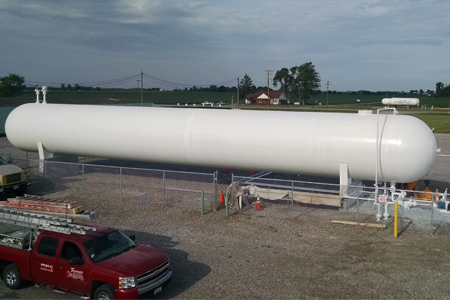
Design, Build and Installation of a Railway Propane Terminal
A large agricultural supplier of propane needed to add rail terminals to their distribution network. UES was called on to design and build a permanent facility in Northwest Ohio that held 60,000 gallons of propane. A second terminal was needed in Northern Iowa, but it would be skid-based 30,000 gallons to allow an easy move to another area if the market changes.
Building a propane rail terminal is a major undertaking that requires a variety of expertise and capabilities such as a thorough knowledge of NFPA 58 code, pumps, motors, and physical properties of propane to name a few.
Utility Energy Systems was called upon to build the terminals after showing a “can do!’ attitude on a smaller project for the customer. A custom control room was built with the design born out of experience from many hours working around bulk propane plants. One important consideration is the unload cycle time of rail cars that come into the terminal. Ideally, it needs to be less than a half hour to empty 30,000 gallons. Design parameters such as this need to be considered to specify pump and piping sizes and configurations.
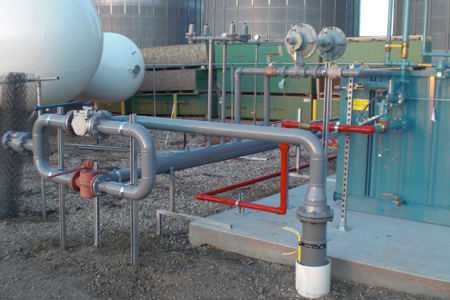
Grain Dryer Propane Tank Installation
A major user of both natural gas and propane is the farmer who dries a lot of grain like corn or beans. Most wise farmers have realized that they can save a lot of money by buying propane by the transport load which is usually around 9,600 gallons. A 12,000-gallon tank can be used but you need to wait until there are 600 gallons left before you can schedule in another transport load. That is a coordination balancing act that is hard to manage when there is uncertainty due to everyone else ordering propane during peak drying times. So. the ideal entry point for a farmer is to get an 18,000-gallon tank. Usually what happens is the farmer will replace the 18,000-gallon tank with a larger 30,000-gallon tank after the first tank is paid for. When buying a used tank, age does not really matter that much if the tank is in good condition with a minimal amount of rust. It is recommended to replace all the valves including relief valves when the tank is empty. Another key point is to ensure the tank has a proper readable manufacturing plate with the proper “U” stamp. Some states even require a national board number or a U-1-A report which is in effect its birth certificate.
Another consideration for the use of propane for drying even when a customer is on the natural gas line is the capacity that is allocated based on the number and types of users and pipeline sizing. An SNG system may be needed to supply peak demands of drying while still operating a base load of natural gas.
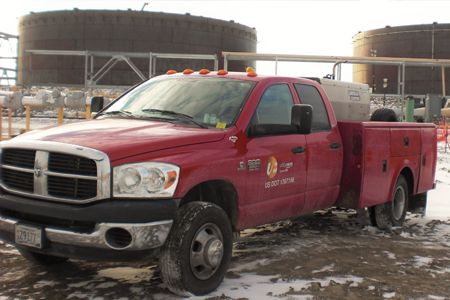
Existing System Review and Updating
"Boyd, can you come out and take a look at this propane system? It is the most messed up system that I have ever seen," said the voice on the other end of the phone. It is nice to get referrals from people that Utility Energy Systems has worked with in the past. Within hours after hanging up the phone, Boyd packed quickly and took a plane for Virginia to see how bad it really was.
What was the problem in this situation? Some mechanical contractors, while not their primary business, have installed propane systems. Design and operational flaws may show up later. In this case, multiple tanks were installed without check valves resulting in a potential overfill condition in the lower tank because the tanks were installed at different heights. Also, an oil separator was needed to collect the “heavies” that exist in propane.
With over 25 years in the gas business, Boyd has seen a lot of systems. It doesn’t take long to zero in on the problem and provide a low-cost solution quickly to get a system running smoothly and safely.
After leaving the big corporate world of mergers and acquisitions, Boyd brought his expertise to concentrate on a performance-based SNG company, Utility Partners, Inc. That has been expanded on through the creation of Utility Energy Systems on service, sales, and rentals of propane equipment -- blenders, pumps, tanks, blenders, and propane vaporizers in MN.
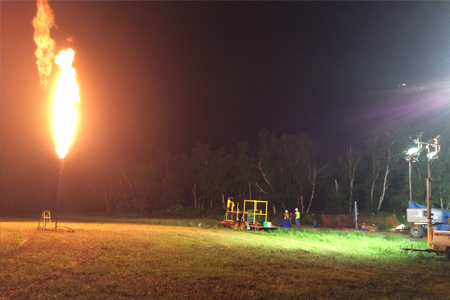
Emergency Response to a Pipeline Repair
Utility Energy Systems (UES) received a call from a local pipeline repair company looking for flaring equipment so that they could replace a section of a propane pipeline in central Wisconsin. Evidently, a farmer had gotten stuck in a marshy area where the high-pressure pipeline was not as deep as in other areas. Also, through time the pipeline had “floated” closer to the surface. In the process of trying to get his tractor out of the marsh, he had driven back and forth over the pipeline bending it severely and fortunately stopped when he had realized what he was resting on. It was an 8-inch pipeline operating at 700 pounds per square inch pressure.
UES had the flaring equipment; but after some discussion, it was found that they needed a vaporizer to ensure the evacuation of the liquid propane in the section of pipe in a timely fashion. Within a few hours, UES, with a two-man crew, trailered two direct-fired vaporizer skids and equipment to the site. In order to replace the pipe, all the liquid within the damaged section had to be evacuated safely. The pipe was 120 feet long and it took six hours to burn off the propane in order to repair it.
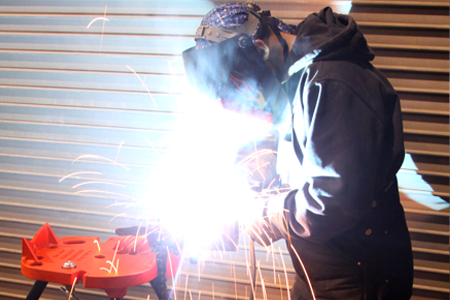
Converting Facility from LP to Natural Gas
Converting a major casino to run on natural gas instead of propane is a study in coordination to minimize any impact on the ongoing business.
Basically, pipe is laid out to provide natural gas in parallel to the existing propane pipe. It is also a time to assess the existing equipment and determine if it needs to be replaced outright or more cost-effective to convert to natural gas individually. As equipment is being hooked up starting with the regulators, there needs to be the proper conversion of each appliance on the gas load. Gas safety switches need to be modified with conversion kits or need to be replaced. Orifices need to be replaced or drilled out to the correct diameter. Holes in burner orifices are larger for natural gas. Then all appliances need to be tested for burner combustion efficiency and adjusted with manometers. All pipe needs to be welded by a certified welder and pressure tested for natural gas use. The layout of long lengths of three- or four-inch pipe is a major effort in itself.
Usually, there is a large propane tank or two that can be downsized to use for an SNG backup system to get on the interruptible gas rate instead of the firm rate. This requires a blender to be added if the existing propane vaporizer in MN or other areas is in good shape to be used. Also, the surplus tank needs to be removed after flaring and site work is completed to leave a nice-looking area.
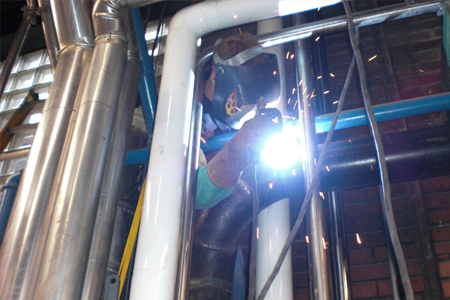
Custom Welded Fabrication
Every project that Utility Energy Systems works on is different. It is no surprise that we are called upon to solve challenges by fabricating a unique design that is not available off the shelf. We have a staff of three full-time welders who are kept busy with the design, fabrication, and installation of gas systems. This expertise is transportable to other industries such as manufacturing, water treatment, and wastewater plants.
UES welders are fully certified to work on a variety of materials and specifications. If you have a unique project that requires welding, give UES a call and we can give you a quick quote.
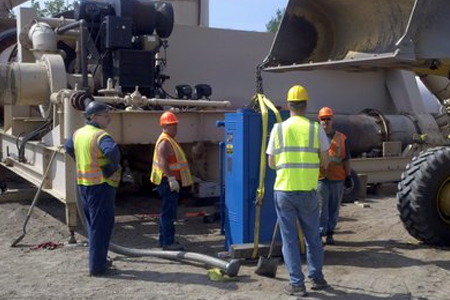
Soil Remediation With Propane
A semi-truck hit a freight train in which a rail tanker filled with a petroleum-based chemical was punctured. About 30,000 gallons had leaked onto the ground and pooled in a ditch in a rural area near Thief River Falls, MN. The spill was contained and later vacuumed up. Utility Energy Systems (UES) was called upon to provide a quick solution to return the soil to an inert state. Taking the affected soil to a facility to process would have been quite expensive, so the decision was made to process the material locally in a nearby area. The contaminated topsoil was trucked to a lined pad a quarter-mile away.
The solution was to send a water bath vaporizer, WBV-640, to provide 57 million BTU of propane vapor and connect it to a propane tank in order to fire the incinerator burners. The incinerator broke down the VOCs at a temperature of 800F. It was returned to the ground at 180F. in a harmless condition. Processed soil was taken to a landfill. Challenges of the project included the remote location where electricity was not available and coordinating the delivery of propane, incinerator, and propane vaporizer in MN to return the soil to a benign state. Air was constantly being monitored around the area to ensure public health.
Vaporized propane is used quite regularly in cleaning up material to remove harmful chemicals. One company in the southeast cleans up old landfill sites which are usually in remote locations far from electricity and natural gas. Not only do they remove the VOCs but as a side benefit they mine for materials such as silver, gold, or aluminum that reduces the cost of the overall cleanup. Different types of burners have been proposed for hazardous waste incineration such as the multiple hearth incinerator where a central shaft with rabble arms and teeth rotate to agitate and convey the waste through the incinerator. This has been used for sewage sludge for many years. In Situ, vitrification is also used. Whatever the technology is used in a remote thermal process, propane is the best solution and Utility Energy Systems can help meet your needs with the propane side of the equation.

Underground Tank Installation
There are many reasons why deciding to install an underground (UG) tank instead of an above-ground tank makes more sense to people. Sometimes that is the only option because of space limitations or setbacks. There are also subjective or soft reasons beyond the NFPA code restrictions. They include the “out of sight, out of mind” or aesthetic reasoning because people don’t want to look at an “ugly” tank where they live. Such is the case in a view from a farmhouse. Another reason that we have been hearing recently has been to minimize the visual exposure to allay fears of tampering or mischief. Such is the case at a school. Another reason is the safety aspect of vehicular traffic and space limitations.
What are the installation differences over above-ground tanks? First of all, it has to be designed for underground use. The manufacturing plate will specify the application. There is a special coating applied to UG tanks. The tanks need to be set in soft sand to eliminate the case of a sharp object like a rock rubbing through the coating and allowing a place for corrosion to start. Also, an anode bag system for cathodic protection is included similar to the sacrificial metals concept used on ships hulls. These anode bags containing magnesium need to be tested and replaced periodically. Voltage potential relative to steel is -.5 volts. Magnesium gives a potential measurement of -1.75 volts. To protect the tank the voltage should be at least -.85 volts so combining the anode bag to the steel tank gives a greater average voltage over a minus volt. This makes the tank a cathode.
Access to valves and gauges is needed and there are several ways to solve that. A simple “doghouse” arrangement using a steel cellar door is one method. Consideration needs to be given to the water table level as well as the proposed site to avoid any “surprises’ that may be buried where you want your tank.
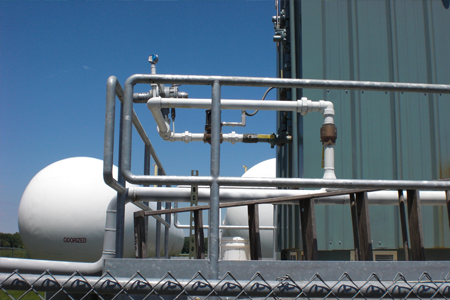
Natural Gas Peak Shaving Can Keep Local Utility Supplier Costs Down!
Energy suppliers to your community you are "on" 24/7/365 to provide safe and reliable energy. Square this with the requirement municipal utilities are under to minimize capital expenditures and bonding yet to reduce costs. Add in that we are located in gas markets that operate in a highly volatile capacity environment where the market price of natural gas is driven by supply and demand on any particular day. Spikes in gas demand typically occur in the colder months in our northern states due to its seasonal weather. The problem is to figure out how much effect the weather has on future demand and usage. Some utilities hire meteorologists to predict the long-term weather patterns that may impact gas demand and usage; however, there are surprise events that affect the cost of gas supply. A major consideration these days is to provide a backup for planned and unplanned interruptions. Interruptions can result from a weather event or an accidental break due to a construction mishap, or simply cold weather that exceeds capacity projections.
Isn’t it nice to wake up on a frosty morning and find your furnace still running? Everybody takes that for granted but multiply that feeling by thousands on the distribution pipeline. Utilities have to keep that in mind when extremely cold weather over a long span occurs. SOL and critical days are rolled out to keep pressure and capacity up to safe levels. You are discovering that there are opportunities to reduce capacity costs related to providing gas services to your members or communities by buying assets while there are good opportunities to reduce costs. Options that the utilities use for buying gas include fixed prices, call options, and monthly and daily indexes. Pre-buying to cover additional demand can be expensive if the supply is not used. One analogy that has been used to illustrate this is to buy a semi-truck and trailer to go grocery shopping. You know you’ll have enough capacity, but a lot of the capacity will be wasted.
One alternative to over-buying is to put into place a peak shaving gas facility as a source of supply to ride through peak events. The question then is how to implement that approach in the most cost-effective manner possible. Another benefit of having a peak shaving system is to quickly respond to new business or business expansion that would require more gas in the outlying areas. Some utilities have been able to add new business by placing a "loadshed" on-site.

Share On: